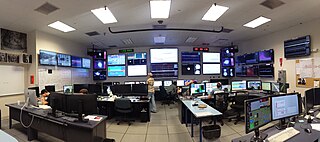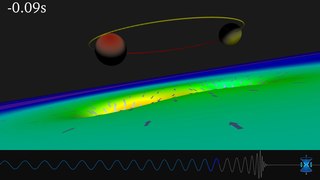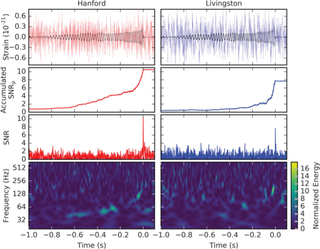Related Research Articles

In physics, gravity (from Latin gravitas 'weight') is a fundamental interaction which causes mutual attraction between all things that have mass. Gravity is, by far, the weakest of the four fundamental interactions, approximately 1038 times weaker than the strong interaction, 1036 times weaker than the electromagnetic force and 1029 times weaker than the weak interaction. As a result, it has no significant influence at the level of subatomic particles. However, gravity is the most significant interaction between objects at the macroscopic scale, and it determines the motion of planets, stars, galaxies, and even light.
The following is a timeline of gravitational physics and general relativity.

The Laser Interferometer Gravitational-Wave Observatory (LIGO) is a large-scale physics experiment and observatory designed to detect cosmic gravitational waves and to develop gravitational-wave observations as an astronomical tool. Two large observatories were built in the United States with the aim of detecting gravitational waves by laser interferometry. These observatories use mirrors spaced four kilometers apart which are capable of detecting a change of less than one ten-thousandth the charge diameter of a proton.

Rainer "Rai" Weiss is a German-born American physicist, known for his contributions in gravitational physics and astrophysics. He is a professor of physics emeritus at MIT and an adjunct professor at LSU. He is best known for inventing the laser interferometric technique which is the basic operation of LIGO. He was Chair of the COBE Science Working Group.

Einstein@Home is a volunteer computing project that searches for signals from spinning neutron stars in data from gravitational-wave detectors, from large radio telescopes, and from a gamma-ray telescope. Neutron stars are detected by their pulsed radio and gamma-ray emission as radio and/or gamma-ray pulsars. They also might be observable as continuous gravitational wave sources if they are rapidly spinning and non-axisymmetrically deformed. The project was officially launched on 19 February 2005 as part of the American Physical Society's contribution to the World Year of Physics 2005 event.

Ronald William Prest Drever was a Scottish experimental physicist. He was a professor emeritus at the California Institute of Technology, co-founded the LIGO project, and was a co-inventor of the Pound–Drever–Hall technique for laser stabilisation, as well as the Hughes–Drever experiment. This work was instrumental in the first detection of gravitational waves in September 2015.
The gravitational wave background is a random background of gravitational waves permeating the Universe, which is detectable by gravitational-wave experiments, like pulsar timing arrays. The signal may be intrinsically random, like from stochastic processes in the early Universe, or may be produced by an incoherent superposition of a large number of weak independent unresolved gravitational-wave sources, like supermassive black-hole binaries. Detecting the gravitational wave background can provide information that is inaccessible by any other means about astrophysical source population, like hypothetical ancient supermassive black-hole binaries, and early Universe processes, like hypothetical primordial inflation and cosmic strings.

The Virgo interferometer is a large Michelson interferometer designed to detect the gravitational waves predicted by general relativity. It is located in Santo Stefano a Macerata, near the city of Pisa, Italy. The instrument's two arms are three kilometres long, housing its mirrors and instrumentation inside an ultra-high vacuum.

Gravitational waves are waves of the intensity of gravity that are generated by the accelerated masses of binary stars and other motions of gravitating masses, and propagate as waves outward from their source at the speed of light. They were first proposed by Oliver Heaviside in 1893 and then later by Henri Poincaré in 1905 as the gravitational equivalent of electromagnetic waves. Gravitational waves are sometimes called gravity waves, but gravity waves typically refer to displacement waves in fluids. In 1916 Albert Einstein demonstrated that gravitational waves result from his general theory of relativity as ripples in spacetime.
David Howard Reitze is an American laser physicist who is professor of physics at the University of Florida and served as the scientific spokesman of the Laser Interferometer Gravitational-Wave Observatory (LIGO) experiment in 2007-2011. In August 2011, he took a leave of absence from the University of Florida to be the Executive Director of LIGO, stationed at the California Institute of Technology, Pasadena, California. He obtained his BA in 1983 from Northwestern University, his PhD in physics from the University of Texas at Austin in 1990, and had positions at Bell Communications Research and Lawrence Livermore National Laboratory, before taking his faculty position at the University of Florida. He is a Fellow of the American Physical Society, the Optical Society, and the American Association for the Advancement of Science.

A neutron star merger is the stellar collision of neutron stars.

The first direct observation of gravitational waves was made on 14 September 2015 and was announced by the LIGO and Virgo collaborations on 11 February 2016. Previously, gravitational waves had been inferred only indirectly, via their effect on the timing of pulsars in binary star systems. The waveform, detected by both LIGO observatories, matched the predictions of general relativity for a gravitational wave emanating from the inward spiral and merger of a pair of black holes of around 36 and 29 solar masses and the subsequent "ringdown" of the single resulting black hole. The signal was named GW150914. It was also the first observation of a binary black hole merger, demonstrating both the existence of binary stellar-mass black hole systems and the fact that such mergers could occur within the current age of the universe.

GW151226 was a gravitational wave signal detected by the LIGO observatory on 25 December 2015 local time. On 15 June 2016, the LIGO and Virgo collaborations announced that they had verified the signal, making it the second such signal confirmed, after GW150914, which had been announced four months earlier the same year, and the third gravitational wave signal detected.

GW 170817 was a gravitational wave (GW) signal observed by the LIGO and Virgo detectors on 17 August 2017, originating from the shell elliptical galaxy NGC 4993. The signal was produced by the last moments of the inspiral process of a binary pair of neutron stars, ending with their merger. It is the first GW observation that has been confirmed by non-gravitational means. Unlike the five previous GW detections—which were of merging black holes and thus not expected to produce a detectable electromagnetic signal—the aftermath of this merger was seen across the electromagnetic spectrum by 70 observatories on 7 continents and in space, marking a significant breakthrough for multi-messenger astronomy. The discovery and subsequent observations of GW 170817 were given the Breakthrough of the Year award for 2017 by the journal Science.

NGC 4993 is a lenticular galaxy located about 140 million light-years away in the constellation Hydra. It was discovered on 26 March 1789 by William Herschel and is a member of the NGC 4993 Group.
PyCBC is an open source software package primarily written in the Python programming language which is designed for use in gravitational-wave astronomy and gravitational-wave data analysis. PyCBC contains modules for signal processing, FFT, matched filtering, gravitational waveform generation, among other tasks common in gravitational-wave data analysis.

Karan Jani is an Indian astrophysicist working on black holes, gravitational waves, and testing Albert Einstein's General Theory of Relativity. He is currently an assistant professor of physics and astronomy at Vanderbilt University, and holds the endowed position of Cornelius Vanderbilt Dean’s Faculty Fellow. He has worked at the LIGO Livingston Observatory in the US, the Albert Einstein Institute in Germany, the Georgia Institute of Technology, and the Perimeter Institute for Theoretical Physics in Canada. He is a member of the Indian Initiative in Gravitational-wave Observations effort to build a gravitational wave detector LIGO in India.
Peter Reed Saulson is an American physicist and professor at Syracuse University. He is best known as a former spokesperson for the LIGO collaboration serving from 2003 to 2007 and research on gravitational wave detectors.

Rana X. Adhikari is an American experimental physicist. He is a professor of physics at the California Institute of Technology (Caltech) and an associate faculty member of the International Centre for Theoretical Sciences of Tata Institute of Fundamental Research (ICTS-TIFR).
References
- ↑ Kalmus, Peter (July 10, 2017). Being the change: live well and spark a climate revolution. Gabriola Island, BC, Canada: New Society Publishers. ISBN 978-0-86571-853-1. Paperback edition.
- ↑ Sharwood, Anthony (June 27, 2017). "Why This NASA Jet Lab Scientist Will Never Go Near A Jet Again". Huffington Post. Archived from the original on November 17, 2018. Retrieved December 7, 2018.
- ↑ Being the Change: A New Kind of Climate Documentary (2018) - IMDb, archived from the original on April 15, 2022, retrieved September 15, 2019
- ↑ "No Fly Climate Sci". Earth scientists flying less. Archived from the original on December 30, 2021. Retrieved December 30, 2021. Website.
- 1 2 3 4 "Peter Kalmus CV 2018" (PDF). Archived (PDF) from the original on August 1, 2019. Retrieved August 1, 2019.
- ↑ Thaddeus, P.; Gottlieb, C. A.; Kalmus, P.; McCarthy, M. C.; Travers, M. J. (November 20, 1996). "Laboratory Detection of the Cyanopolyyne HC13N". The Astrophysical Journal Letters. 472 (1): L61. Bibcode:1996ApJ...472L..61T. doi: 10.1086/310359 . ISSN 1538-4357.
- ↑ Kalmus, Peter (April 28, 2009). "Search for Gravitational Wave Bursts from Soft Gamma Repeaters". arXiv: 0904.4394 . Bibcode:2009PhDT.......272K.
{{cite journal}}: Cite journal requires|journal=(help) - ↑ LIGO Scientific Collaboration; Abbott, B.; Abbott, R.; Adhikari, R.; Ajith, P.; Allen, B.; Allen, G.; Amin, R.; Anderson, S. B. (November 21, 2008). "Search for Gravitational-Wave Bursts from Soft Gamma Repeaters". Physical Review Letters. 101 (21): 211102. arXiv: 0808.2050 . Bibcode:2008PhRvL.101u1102A. doi:10.1103/PhysRevLett.101.211102. PMID 19113401. S2CID 20300387.
- ↑ Abbott, B. P.; Abbott, R.; Adhikari, R.; Ajith, P.; Allen, B.; Allen, G.; Amin, R. S.; Anderson, S. B.; Anderson, W. G. (July 2009). "Stacked Search for Gravitational Waves from the 2006 SGR 1900$\mathplus$14 STORM" (PDF). The Astrophysical Journal. 701 (2): L68–L74. doi:10.1088/0004-637X/701/2/L68. hdl: 1721.1/95904 . ISSN 1538-4357. S2CID 203045244.
- ↑ Abadie, J.; Abbott, B. P.; Abbott, R.; Abernathy, M.; Accadia, T.; Acernese, F.; Adams, C.; Adhikari, R.; Affeldt, C. (June 2011). "Search for Gravitational Wave Bursts from Six Magnetars". The Astrophysical Journal. 734 (2): L35. arXiv: 1011.4079 . Bibcode:2011ApJ...734L..35A. doi:10.1088/2041-8205/734/2/L35. ISSN 2041-8205. S2CID 119120374.
- ↑ Abadie, J.; Abbott, B. P.; Abbott, T. D.; Abbott, R.; Abernathy, M.; Adams, C.; Adhikari, R.; Affeldt, C.; Ajith, P. (July 2012). "Implications for the Origin of GRB 051103 from Ligo Observations". The Astrophysical Journal. 755 (1): 2. arXiv: 1201.4413 . Bibcode:2012ApJ...755....2A. doi:10.1088/0004-637X/755/1/2. ISSN 0004-637X. S2CID 15494223.
- ↑ LIGO Scientific Collaboration and Virgo Collaboration; Abbott, B. P.; Abbott, R.; Abbott, T. D.; Abernathy, M. R.; Acernese, F.; Ackley, K.; Adams, C.; Adams, T. (November 15, 2016). "First targeted search for gravitational-wave bursts from core-collapse supernovae in data of first-generation laser interferometer detectors". Physical Review D. 94 (10): 102001. arXiv: 1605.01785 . Bibcode:2016PhRvD..94j2001A. doi:10.1103/PhysRevD.94.102001. S2CID 217480132.
- ↑ Goetz, E; Kalmus, P; Erickson, S; Savage, R L; Gonzalez, G; Kawabe, K; Landry, M; Marka, S; O'Reilly, B (November 25, 2009). "Precise calibration of LIGO test mass actuators using photon radiation pressure". Classical and Quantum Gravity. 26 (24): 245011. arXiv: 0910.5591 . Bibcode:2009CQGra..26x5011G. doi:10.1088/0264-9381/26/24/245011. ISSN 0264-9381. S2CID 11311944.
- 1 2 Kalmus, Peter; Lebsock, Matthew; Teixeira, João (December 2014). "Observational Boundary Layer Energy and Water Budgets of the Stratocumulus-to-Cumulus Transition". Journal of Climate. 27 (24): 9155–9170. Bibcode:2014JCli...27.9155K. doi: 10.1175/JCLI-D-14-00242.1 . ISSN 0894-8755.
- 1 2 Kalmus, Peter; Kahn, Brian H.; Freeman, Sean W.; van den Heever, Susan C. (May 2019). "Trajectory-Enhanced AIRS Observations of Environmental Factors Driving Severe Convective Storms". Monthly Weather Review. 147 (5): 1633–1653. Bibcode:2019MWRv..147.1633K. doi: 10.1175/MWR-D-18-0055.1 . ISSN 0027-0644.
- ↑ Kalmus, Peter; Sun Wong; Teixeira, Joao (July 2017). "The Pacific Subtropical Cloud Transition: A MAGIC Assessment of AIRS and ECMWF Thermodynamic Structure". IEEE Geoscience and Remote Sensing Letters. 12 (7): 1586–1590. doi:10.1109/LGRS.2015.2413771. ISSN 1545-598X. S2CID 8487808.
- ↑ "Biological Diversity & Ecological Forecasting". cce.nasa.gov. Archived from the original on August 1, 2019. Retrieved August 1, 2019.
- ↑ "No safe haven for coral from the combined impacts of warming and ocean acidification | NOAA Climate.gov". www.climate.gov. Archived from the original on August 1, 2019. Retrieved August 1, 2019.
- ↑ "Peter Kalmus' Publons profile". publons.com. Archived from the original on August 1, 2019. Retrieved August 1, 2019.
- ↑ "New most followed climate scientist". twitter.com. Archived from the original on April 19, 2022. Retrieved April 19, 2022.
- ↑ Kalmus, Peter. "To My Fellow Climate Scientists: Be Human, Be Brave, Speak Truth". Yes! Magazine. Archived from the original on August 1, 2019. Retrieved August 1, 2019.
- ↑ "What happens when you can see disaster unfolding, and nobody listens?". Mother Jones. Archived from the original on July 23, 2019. Retrieved August 1, 2019.
- ↑ "How do we process doom-and-gloom climate news? How should we?". Public Radio International. Archived from the original on August 1, 2019. Retrieved August 1, 2019.
- ↑ "Climate scientist calls out 25,000 colleagues for flying to conference". CBC Radio. Archived from the original on July 23, 2019. Retrieved August 1, 2019.
- ↑ "German state education minister tells students to protest on their own time | DW | February 16, 2019". DW.COM. Archived from the original on August 1, 2019. Retrieved August 1, 2019.
- ↑ "These Scientists Are Radically Changing How They Live To Cope With Climate Change". BuzzFeed News. Archived from the original on May 19, 2019. Retrieved August 1, 2019.
- ↑ Aronoff, Kate (July 5, 2019). "The PowerPoint That Got a Climate Scientist Disinvited From a Shell Conference". The Intercept. Archived from the original on August 1, 2019. Retrieved August 1, 2019.
- ↑ Neimark, Jill (May 16, 2016). "Stop screaming at us about climate change–and start inspiring us to take action". Quartz. Archived from the original on August 1, 2019. Retrieved August 1, 2019.
- ↑ Kalmus, Peter (2017). Being the Change: Live Well and Spark a Climate Revolution. New Society. p. 144.
- ↑ Kalmus, Peter. "How Far Can We Get Without Flying?". Yes! Magazine. Archived from the original on August 1, 2019. Retrieved August 1, 2019.
- ↑ "What's the most effective way to talk about climate change?". theweek.com. July 15, 2018. Archived from the original on August 1, 2019. Retrieved August 1, 2019.
- ↑ "Peter Kalmus". YES! Magazine. Archived from the original on August 20, 2021. Retrieved August 20, 2021.
- ↑ Kalmus, Peter (December 11, 2017). "Why did climate scientists emit 30,000 tonnes of CO2 this weekend? | Peter Kalmus". The Guardian. ISSN 0261-3077. Archived from the original on July 28, 2019. Retrieved August 1, 2019.
- ↑ "Opinion: How to live with the climate crisis without becoming a nihilist". Los Angeles Times. September 15, 2019. Archived from the original on September 15, 2019. Retrieved September 15, 2019.
- ↑ "Twitter". mobile.twitter.com. Archived from the original on April 22, 2022. Retrieved September 15, 2019.
- ↑ "Movement For A People's Party - A Party For Us". The People's Party. Archived from the original on August 17, 2020. Retrieved October 12, 2020.
- ↑ Kalmus, Peter (December 29, 2021). "I'm a climate scientist. Don't Look Up captures the madness I see every day". The Guardian. London, United Kingdom. ISSN 0261-3077. Archived from the original on December 29, 2021. Retrieved December 29, 2021.
- ↑ Boraks, David (November 11, 2022). "These climate scientists feel 'a higher calling' — civil disobedience". WFAE 90.7. Archived from the original on November 14, 2022. Retrieved November 14, 2022.
- ↑ McFall-Johnsen, Morgan (December 16, 2022). "2 climate activists got kicked out of the world's biggest Earth-science conference for protesting, and one says the association is 'silencing scientists'". Business Insider. Archived from the original on January 10, 2023. Retrieved January 11, 2023.
- ↑ Abramoff, Rose (January 10, 2023). "I'm a Scientist Who Spoke Up About Climate Change. My Employer Fired Me". The New York Times. Archived from the original on January 11, 2023. Retrieved January 11, 2023.
- ↑ "Civil disobedience: 'Climate scientists are citizens and humans too'". Le Monde.fr. January 26, 2023. Retrieved January 27, 2023.
- ↑ "Climate Scientists Chained Themselves To A Downtown Bank's Doors In An Act Of Peaceful Protest. Police In Riot Gear Shut It Down". LAist. April 7, 2022. Archived from the original on April 20, 2022. Retrieved April 20, 2022.
- 1 2 Kalmus, Peter (April 6, 2022). "Climate scientists are desperate: we're crying, begging and getting arrested". The Guardian. London, United Kingdom. ISSN 0261-3077. Archived from the original on April 6, 2022. Retrieved April 6, 2022.
- ↑ Sci, No Fly Climate. "Welcome". Earth scientists flying less. Archived from the original on August 1, 2019. Retrieved August 1, 2019.
- ↑ "AGU Should Support Its Members Who Fly Less". Eos. December 7, 2018. Archived from the original on August 1, 2019. Retrieved August 1, 2019.
- ↑ Lemonick, Michael D. "An Open Letter Endorsing the Global School Strike for Climate". Scientific American Blog Network. Archived from the original on January 18, 2023. Retrieved August 1, 2019.
- ↑ Hagedorn, Gregor; Kalmus, Peter; Mann, Michael; Vicca, Sara; Van den Berge, Joke; van Ypersele, Jean-Pascal; Bourg, Dominique; Rotmans, Jan; Kaaronen, Roope; Rahmstorf, Stefan; Kromp-Kolb, Helga; Kirchengast, Gottfried; Knutti, Reto; Seneviratne, Sonia I; Thalmann, Philippe; Cretney, Raven; Green, Alison; Anderson, Kevin; Hedberg, Martin; Nilsson, Douglas; Kuttner, Amita; Hayhoe, Katharine (April 12, 2019). "Concerns of young protesters are justified". Science. 364 (6436): 139–140. Bibcode:2019Sci...364..139H. doi: 10.1126/science.aax3807 . ISSN 0036-8075. PMID 30975882. S2CID 109938625 . Retrieved November 5, 2021.

- ↑ "Youth Call for Action with Climate Strikes". EosS. March 14, 2019. Archived from the original on September 24, 2019. Retrieved August 1, 2019.
- ↑ "Earth Hero". Earth Hero. Archived from the original on August 1, 2019. Retrieved August 1, 2019.
- ↑ "Transition US Awards Ceremony Honors Movement Leaders | Transition US". www.transitionus.org. Archived from the original on August 1, 2019. Retrieved August 1, 2019.
- ↑ "Meet the people fixing your world". Grist. Archived from the original on August 9, 2019. Retrieved August 1, 2019.
- ↑ "Outstanding". www.ippyawards.com. Archived from the original on October 6, 2018. Retrieved December 6, 2018.